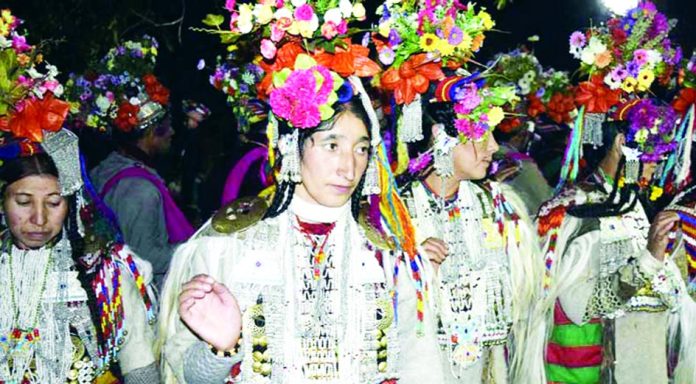Tashi Sharma
In the undulating beauty of Ladakh lies the Aryan villages which were built around 330 BC, which makes them more than 2000 years old. These villages date back to the time of King Alexander, when he returned westward but left behind a few of his clansmen who settled here.
Unknown to many, they still live in the Aryan villages situated in Ladakh. There is actually a cluster of 5 villages close to the Indo-Pak border in Ladakh. Dahanu represents two of these villages – Dah and Hanu while the rest of them are Sanit, Bheema, and Garkon which by the recent were out of bounds to visit due to travel restrictions but are now open to tourists.Located in in the North-East of Ladakh, about 160km from Leh town these villages are less explored tourist spots but are worthwhile visiting.
THE ARYAN RACE
The Aryan race here is referred to as “Brokpa” or “Dards” who are considered to be the direct descendants of Alexander’s army who migrated to the region over two millennia ago .Residents of Dah -Hanu are best known as “Indo-Aryan breed” and they do have an “Indo-European” appearance with high cheekbones, fair complexion ,big Nordic eyes ,sharp features and usually stand out as tall heighted people (going up to 6 feet). The practice of intra-community marriage has contributed to the preservation of the Brokpas’ distinct physical characteristics. Beyond attracting tourists, these villages also draw the interest of anthropologists.
RELIGIOUS COMMUNITIES
The Brokpas are known for their hospitality and strong community bonds.The villages have both Muslim and Buddhist population and also have their own animist pantheon of God. From the tranquil temples to the serene mosques, each corner tells a story of unity in diversity, where shared values and mutual respect form the cornerstone of daily life.
REFLECTION OF THE CULTURE
Residents of these villages don unique costumes adorned with feathers, fur, silver, and beads, a tradition cherished and passed down through generations, fiercely safeguarded from external influence. Women in Dha Village are often seen adorned with elaborate floral headgear, adding a touch of tradition and elegance to their attire.The languages spoken here includes Brolskat,Minaro,Shina and Ladakhi while most of them are very indigenous .Inhabited by the Dropka tribesmen, Dha Village boasts customs divergent from the traditional Ladakhi milieu. Public displays of affection, elaborate headgear, and unconventional practices such as wife swapping, love marriages, and permissive dating are commonplace, echoing cultural norms more akin to those of European nations.
INDIGENOUS FLORA & FAUNA
These villages are abundant in apricots, juicy apples, and delightful black grapes, alongside tomato fields and a diverse array of flowers. Walnut trees and orchids adorn the vibrant landscape, adding to the village’s charm. Self sustenance is primarily done here through animal husbandry, agriculture, and trade. Its exclusive terrain harbors rare species such as the Tibetan antelope and Snow Leopard contributing to the unique allure of the region. Dha Village in Dha Hanu Valley is renowned for its inhabitants who have extensive knowledge of medicinal plants, a cherished expertise passed down through generations.
THE PREGNANCY TOURISM
Though many Indians are unaware about the existence of these villages, many foreign tourists consider visiting these places worthwhile. Some alleged that foreigners visit these places as ‘pregnancy tourism’. Preserving the races and maintaining their Aryan identity is now considered as their responsibility. The Brokpas of these small Valleys with a population of not more than 3000 had their own culture and belief system. To preserve the immaculateness of races they didn’t marry outside their valley. They claim themselves as Aryan and the youths among the Broqpas cultivate their Aryan identity by adding Aryan to the suffix of their name with full spirit and pride.
ATTRACTIONS FOR VISITORS
Once reaching the Aryan villages the cultural element of the place and scenic beauty excites the visitor the most but adding more to the itenary can always turn out to be good thus one may consider visiting ‘Lastangs’ where one can immerse oneself in the authentic essence of Aryan culture and lifestyle, gaining insight into age-old traditions and customs and can also consider visiting, ‘Photang Monastery’, associated with the Dalai Lama, adding a spiritual dimension to their experience. While to experience the natural beauty beyond thoughts one may visit ‘Sanjak Village’ and see deep gorge and slender stream, sourced from the icy ‘Sangeluma Tokpo’ which merges into Indus later. Exiting the gorge of Sanjak Village, Dah Hanu, the valley unfolds, bathed in sunlight that illuminates the fields and homes along the banks of the ‘Tokpo’.
VISITING WORTHWHILE
In the embrace of a beautiful valley, where the whispers of nature mingle with the echoes of ancient traditions, lies a village of remarkable diversity and harmony. Here, amidst the convergence of Buddhist serenity and Islamic piety, a rich tapestry of culture, faith, and community thrives.As the sun sets behind the majestic peaks, casting a golden glow over the valley, one cannot help but marvel at the beauty of coexistence and the power of unity. In this village, where the past meets the present and traditions intertwine, each moment is a celebration of diversity, resilience, and the timeless bond that unites us all.
Trending Now
E-Paper


